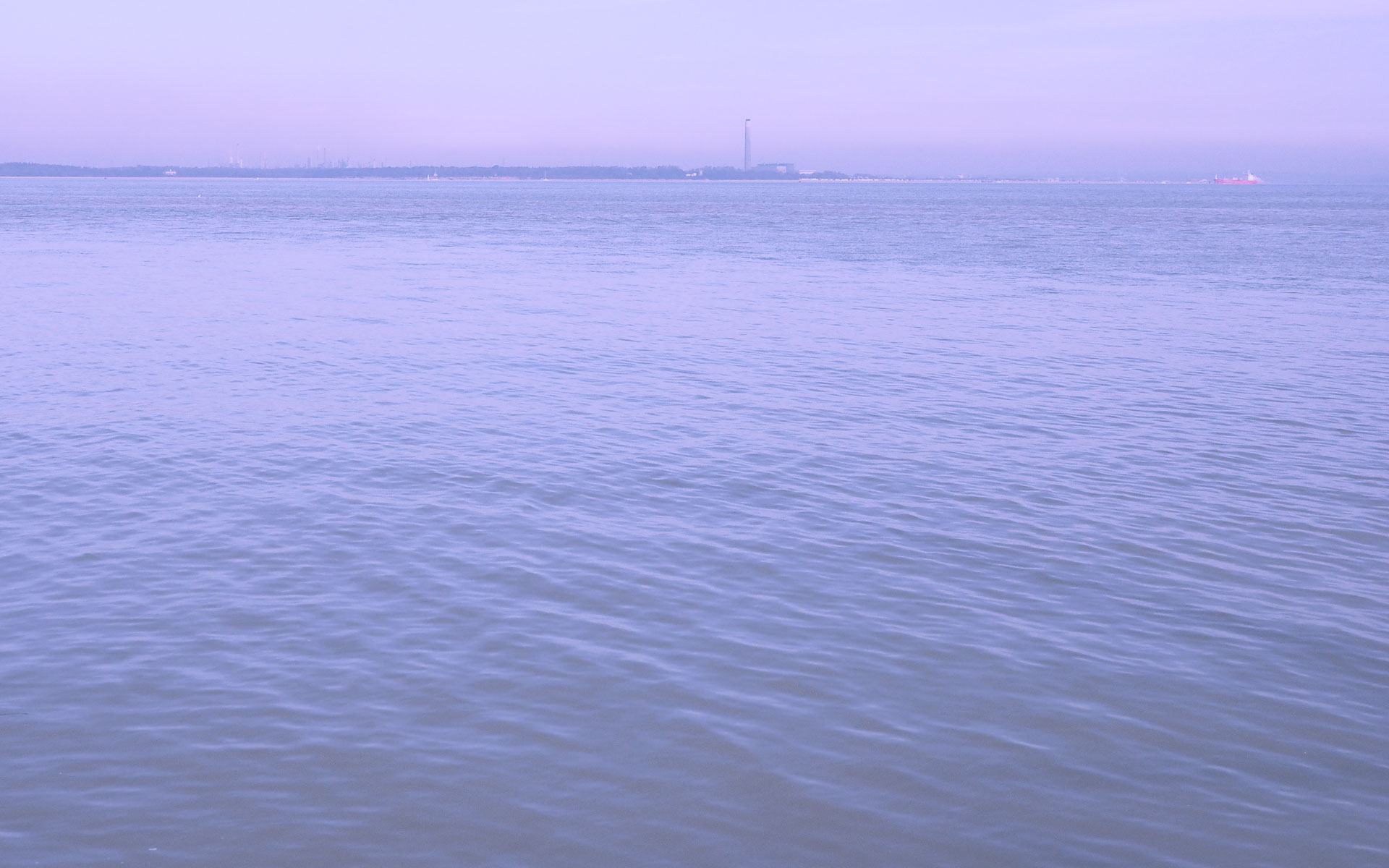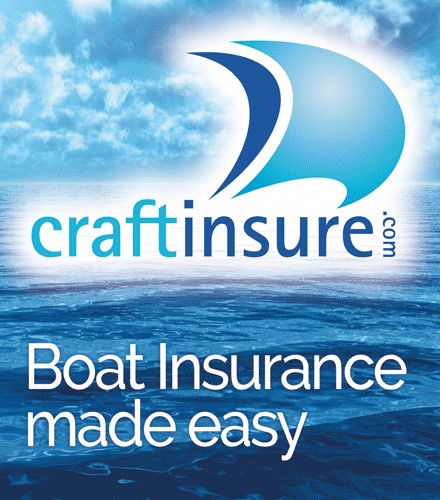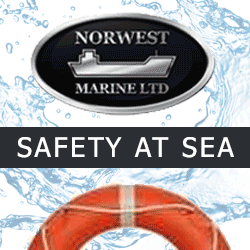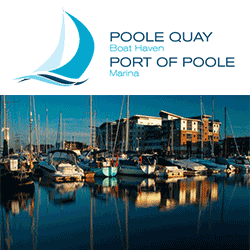Cowes
Cowes is fortunate to enjoy the benefits of its geography and history. Its position at the centre of the Solent, with a harbour that’s easily accessible and a river navigable as far as Newport, has made it the Isle of Wight’s main port as well as a popular destination harbour and events centre for sailing, cruising, and powerboating.
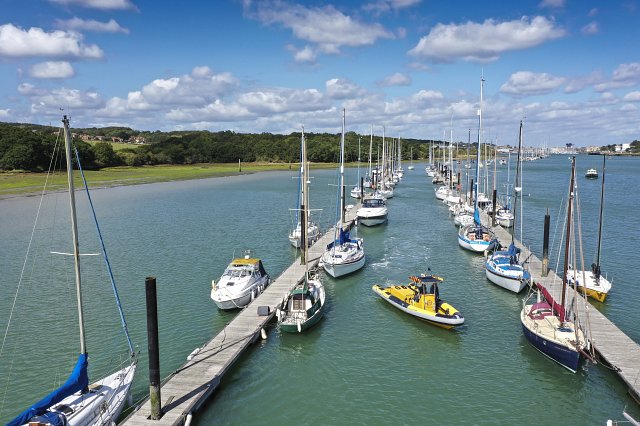
Image Credit: Cowes Harbour Commission
Cowes’ history is steeped in yachting tradition. Even before the 1815 founding in London of The Yacht Club, which went on to become the Royal Yacht Squadron, Cowes was a fashionable watering place. The Cowes Regatta, which was based on the annual licensing of the local pilot vessels and races between them, was a popular spectator sport for visitors even before the advent of Cowes Week. When Queen Victoria’s court was at Osborne House the town became famous for yachting and social events.
Today, Cowes has evolved to meet the demands of a growing leisure marine audience and tourist visitors. The harbour and river offer easy access and a choice of mooring types, either close to the town or in the more tranquil stretches of the River Medina. In addition to leisure craft, the harbour and river see a large number of commercial movements including Red Funnel car and freight ferries, high-speed Red Jet ferries, and cargo vessels up to 100m and Cruise vessels up to 150m.
Cowes Harbour can be entered by day or night and at all states of the tide by vessels with draft up to about 3 metres. Cowes can be approached safely from the north, east, and west.
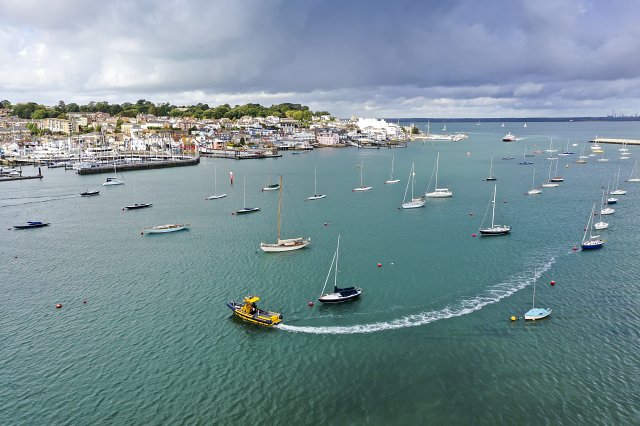
Image Credit: Cowes Harbour Commission
When approaching from the north, care should be taken not to infringe large vessels in the Southampton Precautionary Area. Vessels over 150m in length have a Moving Prohibited Zone that requires smaller craft (< 20m in length) to keep a minimum of 1,000m ahead and 100m either side. The Southampton Precautionary Area can be avoided completely, when taking passage from Southampton Water and the River Hamble, when height of tide permits, by passing to the east of the Bramble Bank and entering Cowes via the Eastern Channel. If approaching from the east, pass 300m north of Old Castle Point leaving the Shrape Beacon to port. Small vessels up to 20m in length may use the Eastern Channel.
The tide gauge on the Shrape Beacon will indicate if the dredged Eastern Channel is safe to use (tide height + 2.25m); if not, head for Egypt Point to the west, leaving any small craft moorings and the Cowes Breakwater to port before entering the Inner Fairway north of the Royal Yacht Squadron.
Vessels entering the Inner Fairway from the Eastern Channel or marinas should do so with caution and give way to any vessel already within the Inner Fairway. Before starting any manoeuvre to turn across the vessel traffic or enter any marina, always give close attention to all other vessels in the vicinity, especially those astern.
If approaching from the west, stay 125m from the shore to avoid rocks along The Green. Vessels need to keep a close lookout for unlit mooring buoys inside the large Gurnard north cardinal buoy and watch out for yachts starting and finishing races off the harbour entrance. The Cowes Outer Fairway extends 500m north of Nos. 1 and 2 buoys.
All vessels must comply with Rule 9 of the Collision Regulations: Navigation in Narrow Channels. Vessels over 20m in length, or those approaching from the west, should enter and leave the Inner Harbour between the green No. 1 and red No. 2 fairway buoys. A sailing vessel fitted with an auxiliary engine must proceed with the engine running and ready for immediate use in the Inner Harbour. Avoid entering the moorings either side of the Eastern channel or the Shrape Watersports Area to the east of the Shrape Breakwater.
The Cowes Breakwater is marked with five GPS-synchronised yellow lights spaced equidistant along the breakwater crest, displaying flash characteristic Fl.Y.2.5s. Stay at least 30m from the breakwater crest as the rock-armoured structure extends 25m to the north and south. The western end, on the Inner Fairway extremity, is marked by a red channel mark Fl.R.2s and the eastern end by a green starboard channel mark Fl.Y.5s. Do not cut inside between these channel marks and the ends of the breakwater; there is limited clearance and obstructions. The Cowes Breakwater is private property. Landing is strictly prohibited and an offence under the Cowes General Directions.
Tidal flows in the deeper water of the Solent can be stronger than in the approaches to Cowes Harbour and may even run in the opposite direction to that between Nos. 1 and 2 buoys. Tides in the approaches to Cowes can run up to 3 knots. These strong tidal streams have a significant effect on the manoeuvrability of commercial shipping and ferries. Vessels under 20m, sailing vessels and fishing vessels must give way to large vessels that can only safely navigate within the Cowes Harbour Outer and Inner Fairways. Just off Nos. 1 and 2 buoys a westerly-going ebb tide runs between HW-2.5hrs and HW+3hrs with maximum rates (up to 2.5 knots on spring tides) around 1 hour after HW. The weaker easterly-going flood tide runs from HW+5hrs to HW-3hrs with rates of up to 1.5 knots on spring tides. When passing west of the Cowes Breakwater and up to No. 2A buoy you may enter a tidal shadow with little movement.
Between No. 2A buoy and No. 4A beacon from HW-2.5hrs to HW, vessels may experience a cross-current of up to 2 knots at spring tides, which has a tendency to set vessels down towards the western shore. This cross-current splits into two separate flows on the western side of the Inner Fairway (between the Island Sailing Club and the Red Jet terminal) with a current of up to 1.5 knots in either direction. Small craft transiting between No. 2A buoy and No. 4A beacon should be prepared to alter their heading so as not to be set westwards across the fairway and should avoid impeding the safe passage of commercial shipping and ferries.
At the Chain Ferry, the flood tide can reach 2.5 knots between HW-2.5hrs and HW at spring tides. The ebb tide can reach 4 knots between LW-3hrs and LW at spring tides. Passage to Newport, 2 nautical miles south of the Folly, can generally only take place about 2 hours either side of high tide. Tide gauges are in place on the Shrape Beacon, at Watch House Slip by the Island Sailing Club at Cowes Town Quay, on the 4A beacon at the west end of the Eastern Channel, and at the north end of Medina Wharf opposite East Cowes Marina.
There are frequent ferry movements in the harbour and its approaches. Large vessels, including Red Jet passenger ferries and Red Funnel vehicle and freight ferries, when entering or leaving the harbour between HW-2.5hrs and HW, may be required to remain towards the eastern side of the fairway between No. 2A buoy and the Eastern Channel beacon to avoid being set down onto the western shore. Small craft should be prepared to alter their heading so as not to be set across the fairway when transiting this area and avoid impeding the safe passage of commercial shipping and ferries. Vessels should not overtake on the starboard side of inbound Red Jets approaching their berth at Town Quay, Cowes. Inbound Red Jets sound one short blast and swing to starboard towards the terminal, ejecting a substantial wash from their propulsion units. Red Jets also sound one short blast on departure. When joining the Inner Fairway from the Eastern Channel, always give way to vessels already navigating in the Inner Fairway, especially large ships.
Two Inner Fairway Precautionary Areas are marked on Chart 2793 for “Red Jet Turning and Eastern Channel Traffic Convergence Area” and “Red Funnel Vehicle and Freight Ferry Berthing Area”. Mariners are advised to navigate with particular caution and keep a good lookout.
The speed limit in the Inner Harbour at Cowes is 6 knots through the water. All craft must comply with the speed limit and wash regulations in Cowes Harbour. The Inner Harbour 6 knot speed limit applies in the Cowes Harbour jurisdiction and within 100m of the Mean High Water Mark west and east of the harbour entrance as far as Egypt Point and Old Castle Point. Navigate with care and caution and keep a good lookout for other vessels and swimmers in the water off the beach at Prince’s Green in Cowes. Do not create wash in the Inner Harbour and within 100m of the shore from Egypt Point to Old Castle Point.
The Chain Ferry (Floating Bridge) carries vehicles, bicycles and foot passengers between Cowes and East Cowes, seven days a week, all year round. The Chain Ferry runs a full service with the support of a “pushing vessel” during spring ebb tides. All vessels are to give way to the Chain Ferry apart from those stated in Cowes General Direction 6.5. Vessels requiring an unimpeded passage must establish early contact (call sign ‘Cowes Chain Ferry’) and agree on VHF Ch. 69 which side the ferry will hold for your passage.
The Chain Ferry is situated on a blind bend at the narrowest stretch of the river. Navigate with caution when approaching the ferry, particularly with a following tide. The tidal flow generally accelerates as you approach the ferry due to the river narrowing, which may set you down towards the ferry quicker than you initially anticipated. Give way in good time.
During all tides, especially spring tides, there are strong currents associated in this narrow part of the river. The ebb flows are usually more pronounced than the flood. The ebb tide is accentuated towards the eastern side of the river where the spring ebb may be in excess of 4 knots and cause the unwary to be set down upon the eastern bank, especially near Trinity Wharf and the Red Funnel ferry terminal in East Cowes.
Depending on the tide and position of the Chain Ferry in the river, the depth of navigable water above the level of the chains does vary, being deepest in the centre of the fairway and steadily decreasing towards the banks of the River Medina and at the bow of the ferry. With the Chain Ferry berthed on either the Cowes or East Cowes side, the depth of navigable water above the chains is a minimum of 1.5m below chart datum in the centre of the fairway. For further information contact the Ferry Manager on 01983 293041.
Cowes owes much of its popularity to its location in the centre of the Solent and its position midway between Weymouth (46 nautical miles) and Brighton (53 nautical miles), in the centre of the most popular sailing area in the country. As a result, during the summer season there are lots of recreational craft moored on buoys, pontoons, and pile moorings within Cowes Harbour and along the River Medina. A large number of yacht races start and/or finish in Cowes, and the harbour is also popular with visiting cruisers and powerboaters. The main sailing season runs from April to October with the busiest period during July and August. Cowes Week, which is held in the first half of August, sees the approaches to Cowes Harbour and the fairway become extremely crowded. To contact the Cowes Harbour Master afloat call on VHF Ch. 69 Call Sign ‘HM1’ or ‘Cowes Harbour Radio’ for the Harbour Master’s Office.
Contact: Harbour Office, Town Quay, Cowes, PO31 7AS. Tel: 01983 293952. Email: chc@cowes.co.uk Website: cowes.co.uk
Scrubbing berths can be found at Town Quay next to the Harbour Office, or a lift and scrub can be arranged through one of the marinas or boatyards. Petrol and red diesel are available from the deep water Cowes Harbour Services Fuels berth, which supplies marine fuels, gas and lubricating oils to the commercial and leisure users in the Solent; Lallow’s Boatyard 50m south of Cowes Yacht Haven on the western side of the fairway also sells diesel and petrol however depth is limited to 1 metre below chart datum.
Fresh water is available at Trinity Landing and marinas. There are several public landing places and slipways. In Cowes there is Trinity Landing (the fairway side of the pontoons can be used for pick up and drop off only, whilst the inside face is available for berthing), the Whitegates pontoon for tenders, a slipway between Thetis Wharf and Shepards Marina, Town Quay adjacent to the Red Jet terminal (up to 9m LOA), the Sun Slip off the High Street, the Watch House slip at the end of Watch House Lane at the south end of The Parade, and at Egypt Point there is a slipway east of the Point.
Also, in East Cowes at Bells landing (tidal steps) just north of the Union Flag building, the White Hart slip south of the Red Funnel ferry terminal, the Grid Iron pontoon, immediately north of the Chain Ferry for landing and pickup only, and the Folly slip further up the River Medina.
There is direct access from Town Quay (next to the Red Jet terminal) to the High Street. The pontoon at Trinity Landing also offers walk ashore access. Whitegates visitor pontoons are situated on both sides of the main fairway, south of the Chain Ferry. In addition, from May to October M Row, off The Green, provides heavy-duty deepwater moorings, max LOA 25m. Contact ‘HM1’ on VHF Ch. 69 for mooring at Trinity Landing and any of the mooring buoys.
Cowes Chain Ferry
The Chain Ferry (Floating Bridge) carries vehicles, bicycles and foot passengers between Cowes and East Cowes, seven days a week, all year round. The Chain Ferry runs a full service with the support of a “pushing vessel” during spring ebb tides. The Chain Ferry has right of way over all river traffic. Vessels requiring an unimpeded passage must establish early contact (call sign ‘Cowes Chain Ferry’) and agree on VHF Channel 69 which side the ferry will hold for your passage.
The Chain Ferry is situated on a blind bend at the narrowest stretch of the river. Navigate with caution when approaching the ferry, particularly with a following tide. The tidal flow generally accelerates as you approach the ferry due to the river narrowing, which may set you down towards the ferry quicker than you initially anticipated. Give way in good time.
During all tides, especially spring tides, there are strong currents associated in this narrow part of the river. The ebb flows are usually more pronounced than the flood. The ebb tide is accentuated towards the eastern side of the river where the spring ebb may be in excess of 4 knots and cause the unwary to be set down upon the eastern bank, especially near Trinity Wharf and the Red Funnel ferry terminal in East Cowes.
Depending on the tide and position of the Chain Ferry in the river, the depth of navigable water above the level of the chains does vary, being deepest in the centre of the fairway and steadily decreasing towards the banks of the River Medina and at the bow of the ferry. With the Chain Ferry berthed on either the Cowes or East Cowes side, the depth of navigable water above the chains is a minimum of 1.5m below chart datum in the centre of the fairway. For further information contact the Ferry Manager on 01983 293041.
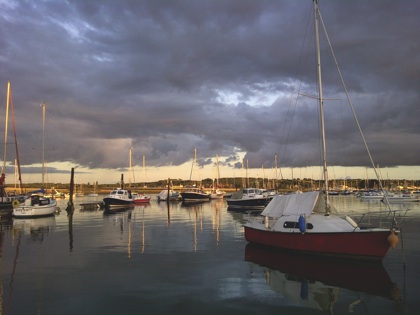
Cowes Yacht Haven
Cowes Yacht Haven is located in the heart of Cowes, giving visitors easy access to a vibrant high street full of independent pubs, restaurants and shops. The marina is accessible at all states of the tide and has 260 fully serviced berths, max LOA 50m.
The marina shower and toilet facilities were upgraded in January 2023. The customer laundry is available for use 24 hours a day.
Onsite in the boatyard there is a 50-ton hoist, 25-ton boat mover and 22-ton 28 metre reach mobile crane, ready to carry out all your lifting requirements, there’s Wi-Fi throughout the site, winter berthing, winter storage ashore, under cover storage, dry sailing services, onsite engineers, electricians and boat repairers all close at hand.
The Pontoon View Bar and Food Outlet is situated at the top of the South Basin ramp is available to all and open daily during the summer season.
Call the office to book any of our services, including overnight berths. On arrival call ‘Cowes Yacht Haven’ on VHF Channel 80 for berthing instructions.
Contact: Cowes Yacht Haven, Vectis Yard, High Street, Cowes PO31 7BD. Tel: 01983 299975. Email: berthing@cowesyachthaven.com Website: cowesyachthaven.com
Cowes Harbour Shepards Marina
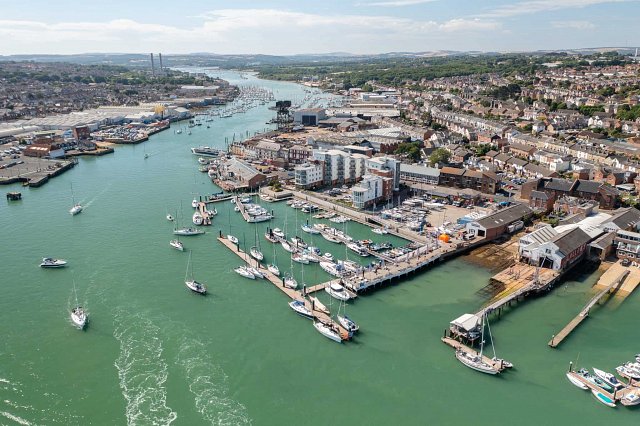
Credit Image: Shepards Marina
Cowes Harbour Shepards Marina is one of Cowes Harbour’s main marina facilities offering a full range of services and amenities suitable for yacht racing events, rallies, and catering also to the cruising sailor and powerboater. The family-friendly marina has capacity for 130 visiting boats, 40 resident berth holders, and specialises in providing dry sailing packages for day class yachts, RIBs, motorboats and trailered keelboats.
The Sugar Store at the marina benefits from a prime waterfront location to host a variety of events. The venue offers contemporary facilities for up to 400 people, with a bar and stage, and regatta/media facilities. Marina services include boat lifting to 6 tonnes, dry sailing, annual moorings, visitor berthing, winter berths and storage, electricity and water, free Wi-Fi, inclusive showers, a free pump out and waste facilities, sitewide CCTV, a restaurant, sail maker, and sailing school.
Berths can be booked in advance; at peak times in season rafting up may be necessary. Rallies, clubs and regattas (of six boats and over) are offered discounts on the standard visitor rates. Sailing schools receive discounted berthing Sunday to Thursday. Discounts are not applicable during major events. Ask at the marina office for more details.
Contact: Shepards Marina; Medina Road, Cowes, PO31 7HT. Tel: 01983 297821.Email: shepards.chc@cowes.co.uk Website: cowes.co.uk App: app.cowes.co.uk VHF Ch80 Call Sign ‘Shepards Marina’
East Cowes Marina
East Cowes Marina is situated in a beautifully sheltered location on the eastern bank of the Medina River, just upstream of the Chain Ferry linking Cowes with East Cowes. VHF 80 Call Sign ‘East Cowes Marina’. The marina provides 240 annual berths and up to 100 visitors’ berths. Visitor berths can be booked in advance, and are all ‘walk-ashore’ with free electricity and fresh water. Shore side facilities include high quality washrooms and showers, a laundry room, car parking, yacht stores and our dedicated boat brokerage, boatpoint. Free Wi-Fi is available across the marina. Next to the marina office the ever popular ‘Lifeboat’ pub with its large, sunny decking area overlooking the river, serves delicious food all day, every day. The marina is a great base for all the Isle of Wight’s major events, including the Round the Island Race, Cowes Week, and the music festivals. East Cowes town has a Waitrose and Co-op, a post office, cash machine, lovely restaurants, cafes and takeaways. There are beautiful river walks, and Osborne House and the Classic Boat Museum are just a few minutes stroll away. Cowes is easily accessible by Chain Ferry or the friendly and efficient Water Taxi service operating from the marina. The marina welcomes rallies and a marquee and BBQ area are available for hire.
Contact: East Cowes Marina, Britannia Way, East Cowes, PO32 6UB. Tel: 01983 293983. Email: eastcowes@boatfolk.co.uk Website: boatfolk.co.uk/east-cowes-marina
Folly Inn
If you wish to travel from East Cowes or Cowes to the Folly Inn, the Folly Waterbus is available on VHF Ch 77 or tel. 07974 864627. There are three visitor pontoons up the Medina River near the Folly Inn, one is a walk ashore and the other two are in mid-river. All are run by the Folly Berthing Master. The walk ashore pontoon has water and electricity, showers and toilets are accessible 24 hours a day at the Folly Inn. There is also a scrubbing berth available nearby. Call on VHF Ch 72 Call Sign ‘Folly Launch’ as you are passing port hand marker No. 10 for berthing instructions.
Contact: Folly Moorings, River Medina, Isle of Wight. Tel: 07884 400046.
Please note, this information is to be used as a guide only and not for navigation.
